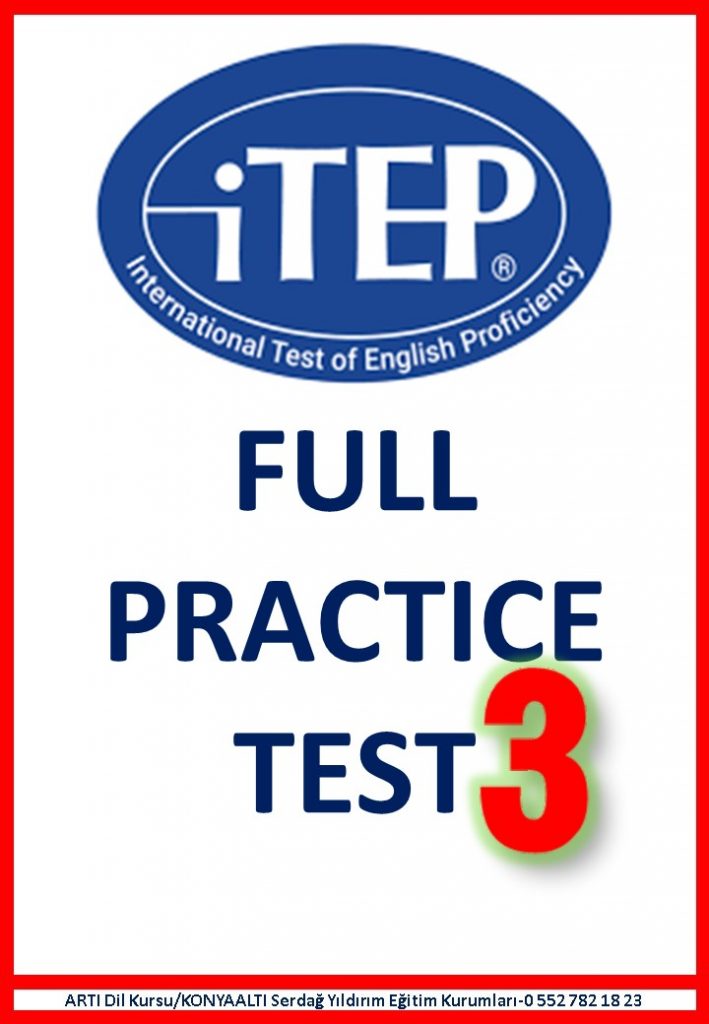ITEP FULL PRACTICE EXAM 3 (ACADEMIC)

CD: https://www.mediafire.com/file/b5o2okajr7jqd09/ITEP_test_3.zip/file
The primary function of iTEP is to assess the English language proficiency of students of English as a second language.
The iTEP Academic exam is commonly used for:
- Admissions decisions
- Placement of students within language programs
- Curriculum development and guiding course instruction
- Progress monitoring from program entry to exit
- Assessing the proficiency of English language teachers
- Determining eligibility for scholarships and academic grants.
THERE ARE TWO VERSIONS OF iTEP ACADEMIC:
- iTEP Academic-Core assesses grammar, listening, and reading, and is 50 minutes in length, with an additional 10 minutes for pre-test preparation.
- iTEP Academic-Plus assesses all three Academic-Core skills plus writing and speaking, and is 80 minutes in length, with an additional 10 minutes for pre-test preparation.
TEST FORMAT & DELIVERY
iTEP exams are delivered via the internet and must be administered at a secure location or a certified iTEP test center. The examinee completes the test in the following manner:
- During the grammar, listening, and reading sections, the examinee clicks on one of four answer choices for each question.
- Writing samples are typed directly into a text-entry field.
- Speaking samples are recorded with a headset and microphone at the examinee’s computer. • iTEP Academic-Core is also available in a paper-based format.
iTEP Academic Structure In each section, examinees will encounter content and questions targeted to varying levels of proficiency. A Grammar (Structure) — 10 minutes/ two parts
Part 1. Thirteen fill-in-the-blank, multiple-choice questions testing the examinee’s familiarity with key features of English structure; questions range from beginner to advanced.
Part 2. Twelve multiple-choice questions where the examinee selects the part of speech with incorrect English structure; questions range from elementary to advanced. B Listening — 20 minutes/ three parts Part 1. Four high-beginning to low-intermediate level short conversations of two to three sentences, each followed by one multiple-choice question. Part 2. One two- to three-minute intermediate-level conversation, followed by four multiple-choice questions.
Part 3. One four-minute upper-level lecture, followed by six multiple-choice questions. C Reading — 20 minutes/ two parts Part 1. One intermediate-level passage of about 250 words in length, followed by four multiple-choice questions. Part 2. One upper-level paragraph of about 450 words in length, followed by six multiple-choice questions. D Writing — 25 minutes/ two parts Part 1. The examinee is given five minutes to write a 50-75 word note on a supplied topic, geared to the low-intermediate level. Part 2. The examinee is given 20 minutes to write a 175-225 word piece expressing and supporting his or her opinion on an upper-level written topic. E Speaking — 5 minutes/ two parts (plus one minute warm-up section) Part 1. The examinee hears and reads a short question geared to low-intermediate level, then has 30 seconds to prepare a spoken response and 45 seconds to speak. Part 2. The examinee hears a brief upper-level statement presenting two sides of an issue, then is asked to express his or her thoughts on the topic, with 45 seconds to prepare and 60 seconds to speak.
Scoring/Grading The test will determine an overall proficiency level from 0 (Beginner) to 6 (Mastery), as well as individual proficiency levels from 0 to 6 for each of the skills and sub-skills tested. The overall scores combine the results of the skill sections, and for greater accuracy, they are expressed to one decimal point (from 0.0 to 6.0). The test is graded as follows: • The grammar, listening, and reading sections are scored automatically by iTEP software. • Each test section is weighed equally, and there is no penalty in the multiple-choice sections for guessing or incorrect answers. • The writing and speaking sections are evaluated by native English-speaking, ESL-trained professionals, according to a standardized scoring rubric. • The official score report presents an individual’s scoring information, displaying an examinee’s strengths and weaknesses in each of the skills and sub-skills tested.
